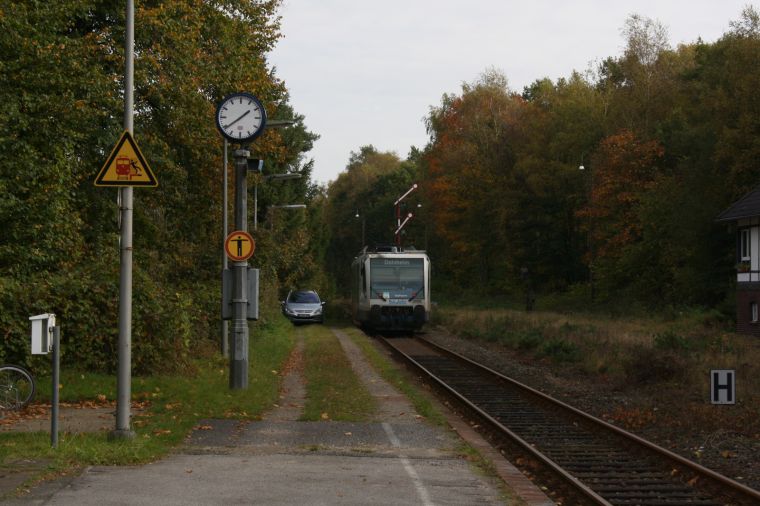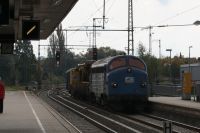Leaving Dalheim

Posted: 20 October 2008
| Taken: | 2008-10-20 19:53:51 |
|---|---|
| Camera: | Canon EOS 1000D |
| Exposure: | -2/1 |
| ISO: | 200 |
| Aperture: | f/11.0 |
| Exposure Time: | 1/250 |
| Focal Length: | 55 mm |

This work is licensed under a Creative Commons Germany license.
Notes
The Regionalbahn (regional train line) 39 Mönchengladbach-Dalheim belongs to the DB’s empire, but is operated under contract by the Rurtalbahn with their quirky Siemens RegioSprinter DMUs. Here, one of them is leaving the end station Dalheim, heading for Mönchengladbach.
This is the Iron Rhine, a line with a long history, so get yourself a cup of coffee. With the Revolution of 1830, Belgium seceded from the Netherlands, which they finally accepted with the Treaty of London in 1839. Like most of the 19th century, treatys at that time were full of more-or-less strange deals. In this case, Belgium had to return the city of Sittard to the Netherlands, but in exchange got the right to build a road or canal through dutch territory via Sittard and Roermond to the prussian (at the time there was no Germany yet) border. They finally did so in 1868, deciding in accordance with technological progress on a railway line instead. Work started in 1873 and the line was opened in 1879. The project was mainly pushed by prussian and, starting in 1871 (when the king of Prussia became emperor of the new German Empire) german interests. The government wanted a connection from the industry in the Rhine-Ruhr-Area to Antwerp, effectively a second connection to the north sea besides the “water” Rhine, hence the name.
The route quickly became a major freight line, but was closed in world war one by the Netherlands due to their neutrality. As a replacement, Germany (occupying Belgium at the time) built a new line just outside the dutch borders, which is these days known as the Montzenroute, my personal favorite. In peace time, the longer new line had the advantage of being cheaper, since the Netherlands did not receive any fees, which meant that all traffic to Antwerp was soon removed from the Iron Rhine, leading to the situation today. Don’t let it fool you: It all looks like a boring branch line, but one can still see the rests of the second track that has been dismantled almost everywhere, and the trains reach a respectable speed of 100 kph (62 mph) according to my GPS device, which is frankly more than I would have though these DMUs were capable of at all.

 Deutsche Version
Deutsche Version Entire Gallery
Entire Gallery

 Next Picture
Next Picture
 Previous Picture
Previous Picture